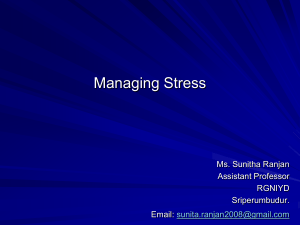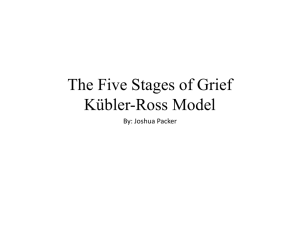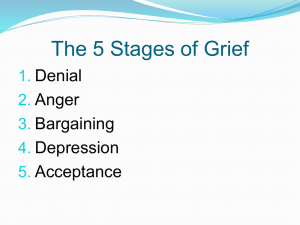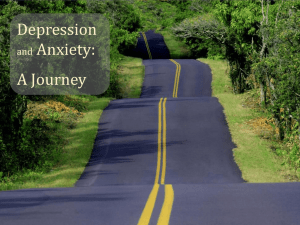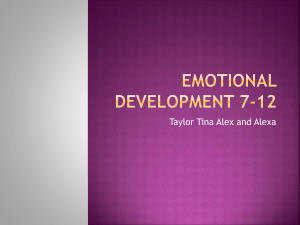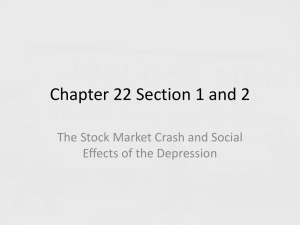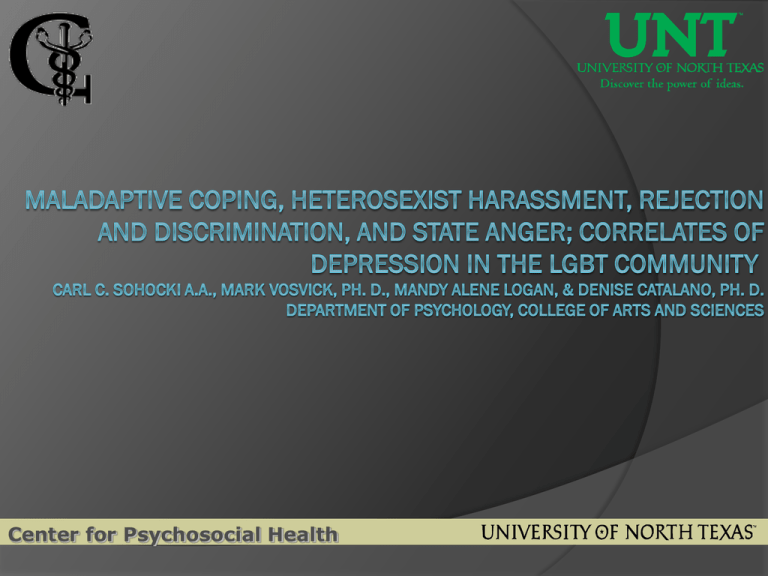
Center for Psychosocial Health
PROJECT HEALTH
This study was designed to:
•Inventory medical conditions and health behaviors that impact the
Lesbian, Gay, Bisexual and Transgendered (LGBT) communities of the
Dallas Metroplex area
•Assess psychosocial factors, such as social support, anger, depression,
stress, and coping to gain a better understanding of the diverse LGBT
communities
•Build onto the existing LGBT literature by examining health-related
behaviors (e.g., obesity and smoking)
•Examine discrimination in healthcare settings for LGBT peoples
•Identify basic healthcare needs for the different LGBT communities and
potential barriers that may be deterring the different communities from
obtaining optimal care
Center for Psychosocial Health
LITERATURE REVIEW
• Compared to heterosexuals, gay and bisexual individuals are at an increased risk for depression
and suicide (Berg, Mimiaga, & Safren, 2008).
• Members of the LGBT community face unique stressors such as harassment, rejection and
discrimination (Friedman, Marshal, Stall, Cheong, & Wright, 2007).
• Among marginalized populations, a relationship exists between perceived discrimination and
anger (Zukoski & Thorburn, 2009) and between perceived discrimination and negative mental
health outcomes, such as suicide ideation and depression (Hwang & Goto, 2009).
• Maladaptive coping strategies (e.g., self- blame, substance use, and denial) have been previously
associated with depression (e.g., Radat et al., 2008).
•Using Lazarus and Cohen’s (1977) transactional model of stress and coping as a framework, we
predict that when faced with HHRD as a stressor, LGBT individuals who react with maladaptive
coping techniques and state anger will have higher levels of depression.
Center for Psychosocial Health
THEORETICAL MODEL
Secondary Appraisal
Outcome
Stressor
State
Anger
Depression
HHRD
Maladaptive
Coping
Lazarus & Cohen, 1977
Center for Psychosocial Health
HYPOTHESES
1.
State anger will be significantly positively correlated with depression.
2.
High levels of maladaptive coping will be significantly positively correlated
with depression.
3.
Heterosexist harassment, rejection, and discrimination will be significantly
positively correlated with depression.
4.
State anger, utilization of maladaptive coping techniques, and heterosexist
harassment, rejection, and discrimination will account for a significant
amount of variance in levels of depression.
Center for Psychosocial Health
MEASURES
Depression
Center for Epidemiologic Studies Depression Scale (CES-D;
Radlof, 1977)
• 20 items on a 4 point likert-type scale (α=.63-.93) used
to assess levels of depression. A score of 16 or greater indicates a high chance
of depressive symptoms.
• 1=rarely/none of the time, 4=most of the time
• “I thought my life had been a failure”
• Concurrent validity was established by Drebbing et al. (1994).
Center for Psychosocial Health
MEASURES CONTINUED
Heterosexist Harassment, Rejection, and Discrimination
Heterosexist Harassment, Rejection and Discrimination Scale
(HHRDS; Szymanski 2006)
• 14 items on a 6 point likert-type scale (α=.9) used to measure perceived
heterosexist harassment, rejection, and discrimination experienced by a
member of the LGBT sample.
• 1= this event has never happened to you, 6= this event happened almost all
the time
• “In the past year, how many times have you been made fun of, picked on,
pushed, shoved, hit, or threatened with harm because you are a
Lesbian/Gay/Bisexual person?”
• Concurrent validity was established by Szymanski (2009).
Center for Psychosocial Health
MEASURES CONTINUED
State Anger
State-Trait Anger Expression Inventory (STAXI; Spielberger,
1999)
• 57 items on a 4 point likert-type scale used to measure intensity of anger as
an emotional state and the disposition to experience angry feelings as
personality trait.
• 1=not at all, 4=very much so
• Concurrent validity was established by Spielberger (1994).
• State Anger: 15 item subscale used to measure anger at a particular moment
as an emotional state (α=.9) “I feel like yelling.”
Center for Psychosocial Health
MEASURES CONTINUED
Maladaptive Coping
Brief COPE (Carver, 1997)
• 28 items on a 4 point likert-type scale (α=.9) used to assess usage of adaptive
and maladaptive coping strategies.
• 1=I haven’t been doing this at all, 4=I’ve been doing this a lot
• “I’ve given up the attempt to cope.”
• In this study we looked specifically at substance use, self blame, and denial
as maladaptive coping mechanisms. Each measure contained 2 items for a
total of 6 items.
Center for Psychosocial Health
PROCEDURE
Data Collection
•Questionnaire Development System (QDS) survey
•Self report
•Dallas based community organization recruitment
•Psychosocial aspects (i.e. depression, HHRD, state anger,
and maladaptive coping)
•Participants received research incentives of 25 dollars for their
time
Center for Psychosocial Health
DEMOGRAPHICS (N=187)
AGE
Mean=34.6
SD=14.1
Range=18-76
SEX
Male
Female
(Frequency)
98
89
52.4%
47.6%
125
22
19
4
17
66.8%
11.8%
10.2%
2.1%
9.1%
50
49
51
37
26.7%
26.2%
27.3%
19.8%
ETHNICITY
European-American
African-American
Latino/a
Asian-American
Other
SEXUAL ORIENTATION
Gay
Lesbian
Bisexual
Transgendered
Center for Psychosocial Health
UNIVARIATE STATISTICS
Mean
(SD)
Actual Range
Possible Range Calculated α
State-Anger 17.28
(4.91)
15-50
15-60
.84
Maladaptive Coping10.60
(3.53)
6-21
6-24
.80
HHRD
23.05 (10.10)
14-79
14-84
.91
Depression
33.56 (10.15)
20-66
20-80
.73
Center for Psychosocial Health
BIVARIATE ANALYSIS
1
2
3
4
5
6
1.Age
—
2.Sex
-.36**
3.EuropeanAmerican
.19**
-.03
4.State-Anger
-.05
.02
-.18*
5.Maladaptive
Coping
-.26**
.11
-.07
.26**
6.HHRD
-.22**
.15*
.10
.07
.20**
7.Depression
-.17*
.05
-.13
.38**
.56**
—
—
*p <.05, **p<.01
Center for Psychosocial Health
—
—
—
.18*
MULTIVARIATE ANALYSIS
CRITERION: Depression
PREDICTORS
β
t
Tolerance
VIF
Age
-.01
-.13
.77
1.31
Sex
-.42
-.33
.86
1.16
-1.36
-1.03
.91
1.10
.49
3.82
.90
1.11
1.37
7.48
.86
1.17
.08
1.30
.90
1.11
European-American
State Anger
Maladaptive Coping
HHRD
adj. R2=.36, F(6, 180)=18.16, p<.001
Center for Psychosocial Health
RESULTS
•Hypothesis 1 supported
1.
State anger was significantly positively
correlated with depression.
•Hypothesis 2 supported
2.
High levels of maladaptive coping was
significantly positively correlated with
depression.
• Hypothesis 3 was partially
supported
3.
Although heterosexist harassment,
rejection, and discrimination were not
significant predictors of depression,
they did contribute to the overall
variance.
• Hypothesis 4 was supported
4.
State anger, utilization of maladaptive
coping techniques, and heterosexist
harassment, rejection, and
discrimination accounted for a
significant amount of variance in levels
of depression.
Center for Psychosocial Health
DISCUSSION
• Minimizing maladaptive coping techniques and state anger may help reduce
depression in LGBT individuals.
• Although we did not find a significant relationship between HHRD and
depression, it did contribute to the overall variance. Given the pervasiveness of
these variables in LGBT communities, these factors should be considered when
examining LGBT samples.
• Future research should examine if a relationship between HHRD on anger or
HHRD and maladaptive coping exists, as well as other predictors of depression
within the LGBT community.
Center for Psychosocial Health
CLINICAL IMPLICATIONS
• Knowing
the predictors of depression specific to this community
could prove invaluable in guiding therapists to more accurately
assess risks to mental health among LGBT individuals and
potentially lead to developing interventions that target healthier
coping alternatives.
Center for Psychosocial Health
LIMITATIONS
•Data collected were self-report
•Ceiling effects in all measures
•Because we used a cross-sectional, correlational
design, causality can not be inferred from our
results.
Center for Psychosocial Health
ACKNOWLEDGEMENTS
•Center for Psychosocial Health Research- Members
and Faculty
•Dallas Resource Center
Center for Psychosocial Health
REFERENCES
Berg, M. B., Mimiaga, M. J., & Safren, S. A. (2008). Mental health concerns of gay and bisexual men seeking mental health services.
Journal of Homosexuality, 54(3), 293-306.
Carver, C. S. (1997). You want to measure coping but your protocol’s too long: Consider the Brief COPE. International Journal of
Behavioral Medicine, 4, 92-100.
Friedman, M. S., Marshal, M. P., Stall, R., Cheong, J., Wright, E. R. (2007). Gay-related development, early abuse and adult health
outcomes among gay males, AIDS and Behavior, 12, 891-902.
Hwang, W., Goto, S. (2009). The impact of perceived racial discrimination on the mental health of Asian American and Latino college
students, Asian American Journal of Psychology, S(1), 15-28
Lazarus, R.S. & Cohen, J.B. (1977). “Environmental Stress”. In I. Altman and J.F. Wohlwill (eds.), Human Behavior and Environment.
(Vol 2) New York: Plenum.
Radat et al (2008). Anxiety, stress and coping behaviours in primary care migraine patients: results of the SMILE study. Cephalalgia,
28, 1115-1125.
Radloff, L.S. (1977). The CES-D Scale: A self-report depression scale for research in the general population. Applied
Psychological Measurement 1(3), 385-401.
Spielberger ,C.D. State-Trait Anger Expression Inventory: Professional Manual. Psychological Assessment Resources, Odessa, FL,
1996.
Szymanski, D. M. (2006). Does internalized heterosexism moderate the link between heterosexist events and lesbians’ psychological
distress? Sex Roles, 54, 227–234.
Zukoski, A. P., Thorburn, S. (2009). Experiences of stigma and discrimination among adults living with HIV in a low HIV-prevalence
context: A qualitative analysis, AIDS Patient Care and STDs, 23(4), 267-276.
Center for Psychosocial Health

